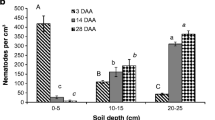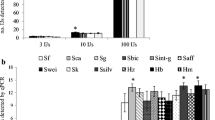Abstract
The vertical and horizontal distribution, as well as the persistence ofSteinernema glaseri, S. carpocapsae (1192, I 100 and Mexican strains),Heterorhabditis bacteriophora, H. heliothidis andHeterorhabditis sp. were studied in three different soil types under field conditions. The presence of infective juveniles in soil samples taken at various depths was assessed usingGalleria mellonella larvae as baits for the nematodes. Results show that all tested nematodes had a similar pattern of vertical distribution. On the other hand,Heterorhabditis spp. were significantly more persistent thanSteinernema spp. in all soil types. As for the horizontal dispersal, none of the nematodes were ever found outside the treated plots, indicating that most of the juveniles remained near the point of application.
Zusammenfassung
Es wurde die Vertikal- und Horizontalverbreitung vonSteinernema glaseri, S. carpocapsae (1192, I 100 und mexikanische Stämme),Heterorhabditis bacteriophora, H. heliothidis undHeterorhabditis sp. in 3 verschiedenen Bodentypen unter Freilandbedingungen untersucht. Die Anwesenheit von infektiven Juvenilen in Bodenproben aus verschiedenen Bodenhorizonten wurde mit Hilfe vonGalleria mellonella-Larven als Köder ermittelt. Die Ergebnisse zeigen, daß alle untersuchten Nematoden ein ähnliches Muster der Vertikalverbreitung aufweisen. Andererseits waren in allen BodentypenHeterorhabditis spp. signifikant beständiger alsSteinernema spp. Bezüglich der horizontalen Ausbreitung war auffällig, daß kein Nematode außerhalb der behandelten Stelle gefunden wurde, woraus hervorgeht, daß die meisten der Juvenilen in der Nähe des Behandlungspunktes bleiben.
Similar content being viewed by others
References
Akhurst, R.J., 1986: Controlling insects in soil with entomopathogenic nematodes. Proc. IV Int. Coll. on Invert. Pathol., Veldhoven (The Netherlands), 265–267.
Bedding, R.A.;Akhurst, R.J., 1975: A simple technique for the detection of insect parasitic rhabditid nematodes in soil. Nematologica21, 109–110.
Georgis, R.;Poinar, G.O. Jr. 1983a: Effect of soil texture on the distribution and infectivity ofNeoaplectana carpocapsae (Nematoda: Steinernematidae). Journal of Nematology15, 308–311.
Georgis, R.;Poinar, G.O. Jr., 1983b: Effect of soil texture on the distribution and infectivity ofNeoaplectana glaseri (Nematoda: Steinernematidae). Journal of Nematology15, 329–332.
Georgis, R.;Poinar, G.O. Jr. 1983c: Vertical migration ofHeterorhabditis bacteriophora andH. heliothidis (Nematoda: Heterorhabditidae) in sandy loam soil. Journal of Nematology15, 652–654.
Ishibashi, N.;Kondo, E., 1986:Steinernema feltiae (DD-136) andS. glaseri: persistence in soil and bark compost and their influence on native nematodes. Journal of Nematology18, 310–316.
Moyle, P.L.;Kaya, H.K., 1981: Dispersal and infectivity of the entomogenous nematode,Neoaplectana carpocapsae Weiser (Rhabditida: Steinernematidae), in sand. Journal of Nematology13, 295–300.
Molyneux, A.S.;Bedding, R.A. 1984: Influence of soil texture and moisture on the infectivity ofHeterorhabditis sp. D1 andSteinernema glaseri for larvae of the sheep blowfly,Lucilia cuprina. Nematologica30, 358–365.
Poinar, G.O. Jr.;Hom, A., 1986: Survival and horizontal movement of infective stageNeoaplectana carpocapsae in the field. Journal of Nematology18, 34–36.
Poinar, G.O. Jr., 1989: Examination of the Neoaplectanid speciesfeltiae Filipjev,carpocapsae Weiser andbibionis Bovien (Nematoda: Rhabditida). Revue de Nématologie, in press.
Pye, A.E.;Pye N.L., 1985: Different applications of the insect parasitic nematodeNeoaplectana carpocapsae to control the large pine weevil,Hylobius abietis. Nematologica31, 109–116.
Schroeder, W.J.;Beavers, J.B., 1987: Movement of the entomogenous nematodes of the families Heterorhabditidae and Steinernematidae in soil. Journal of Nematology19, 257–259.
Author information
Authors and Affiliations
Additional information
With one figure and one table
Rights and permissions
About this article
Cite this article
Rovesti, L., Heinzpeter, E.W. & Deseö, K.V. Distribution and persistence ofSteinernema spp. andHeterorhabditis spp. (Nematodes) under different field conditions. Anz. Schadlingskde., Pflanzenschutz, Umweltschutz 64, 18–22 (1991). https://doi.org/10.1007/BF01906194
Issue Date:
DOI: https://doi.org/10.1007/BF01906194




